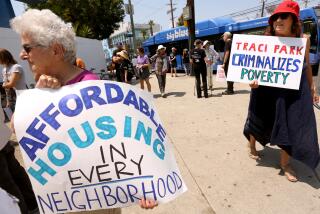Are many homeless people in L.A. mentally ill? New findings back the public’s perception
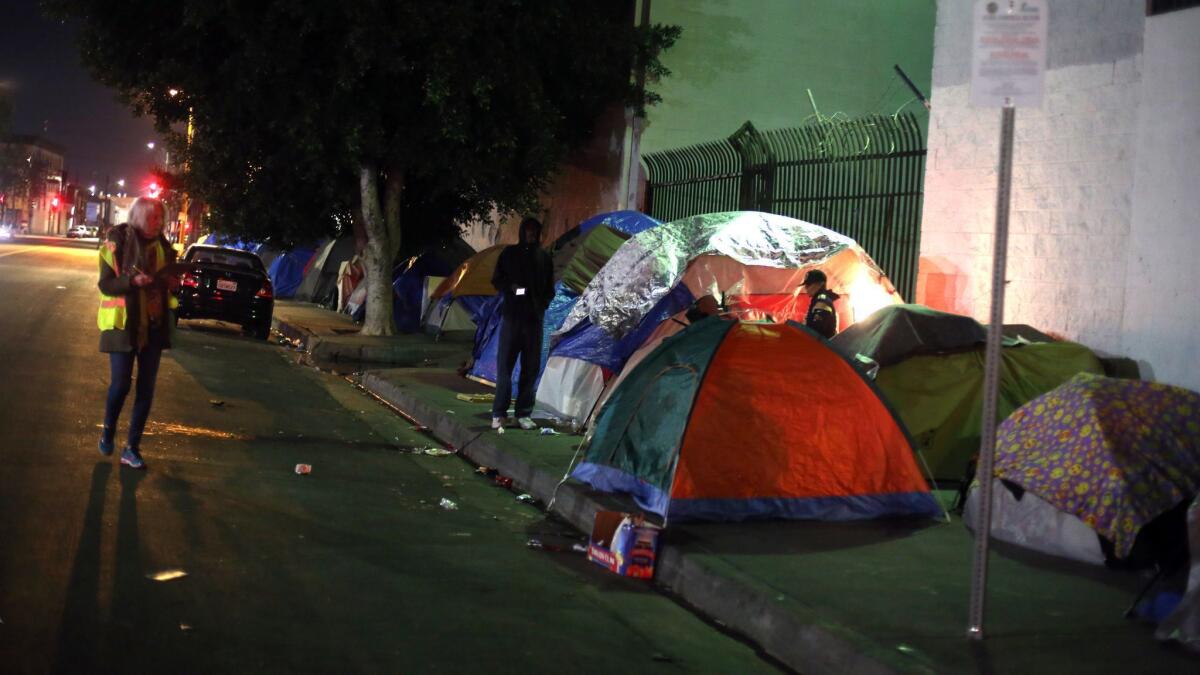
Mental illness, substance abuse and physical disabilities are much more pervasive in Los Angeles County’s homeless population than officials have previously reported, a Times analysis has found.
The Times examined more than 4,000 questionnaires taken as part of this year’s point-in-time count and found that about 76% of individuals living outside on the streets reported being, or were observed to be, affected by mental illness, substance abuse, poor health or a physical disability.
The Los Angeles Homeless Services Authority, which conducts the annual count, narrowly interpreted the data to produce much lower numbers. In its presentation of the results to elected officials earlier this year, the agency said only 29% of the homeless population had either a mental illness or substance abuse disorder and, therefore, 71% “did not have a serious mental illness and/or report substance use disorder.”
The Times, however, found that about 67% had either a mental illness or a substance abuse disorder. Individually, substance abuse affects 46% of those living on the streets — more than three times the rate previously reported — and mental illness, including post-traumatic stress disorder, affects 51% of those living on the streets, according to the analysis.
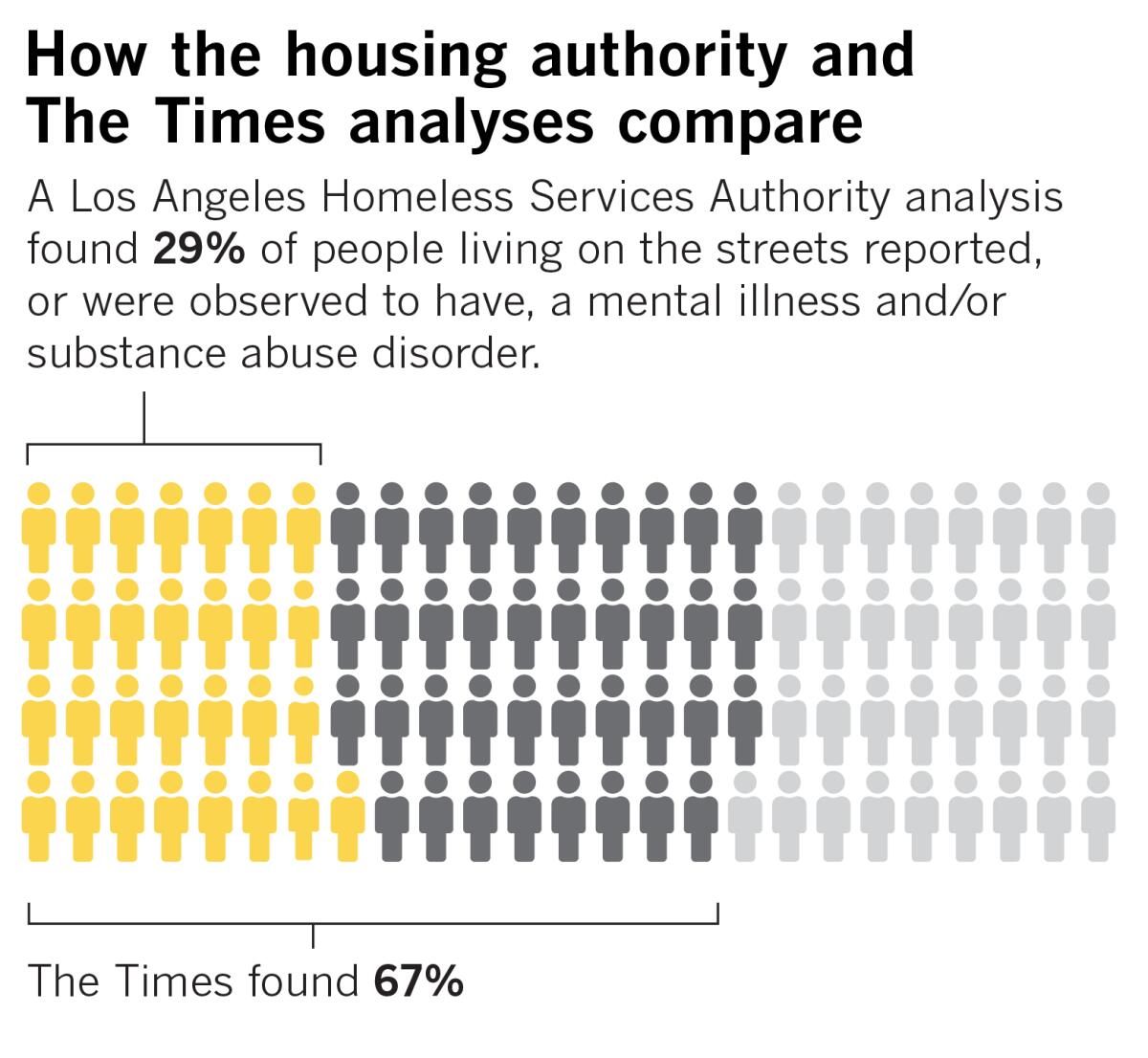
The homeless services authority did not dispute what The Times found. Rather, Heidi Marston, the agency’s acting executive director, explained that its report was in a format required by federal guidelines, leading to a different interpretation of the statistics.
“We’re acknowledging that there are more layers to the story,” Marston said.
The Times analysis aligns with a national study released Sunday by the California Policy Lab at UCLA, which found even higher rates in most categories. It also found that a mental health “concern” affected 78% of the unsheltered population and a substance abuse “concern,” 75%.
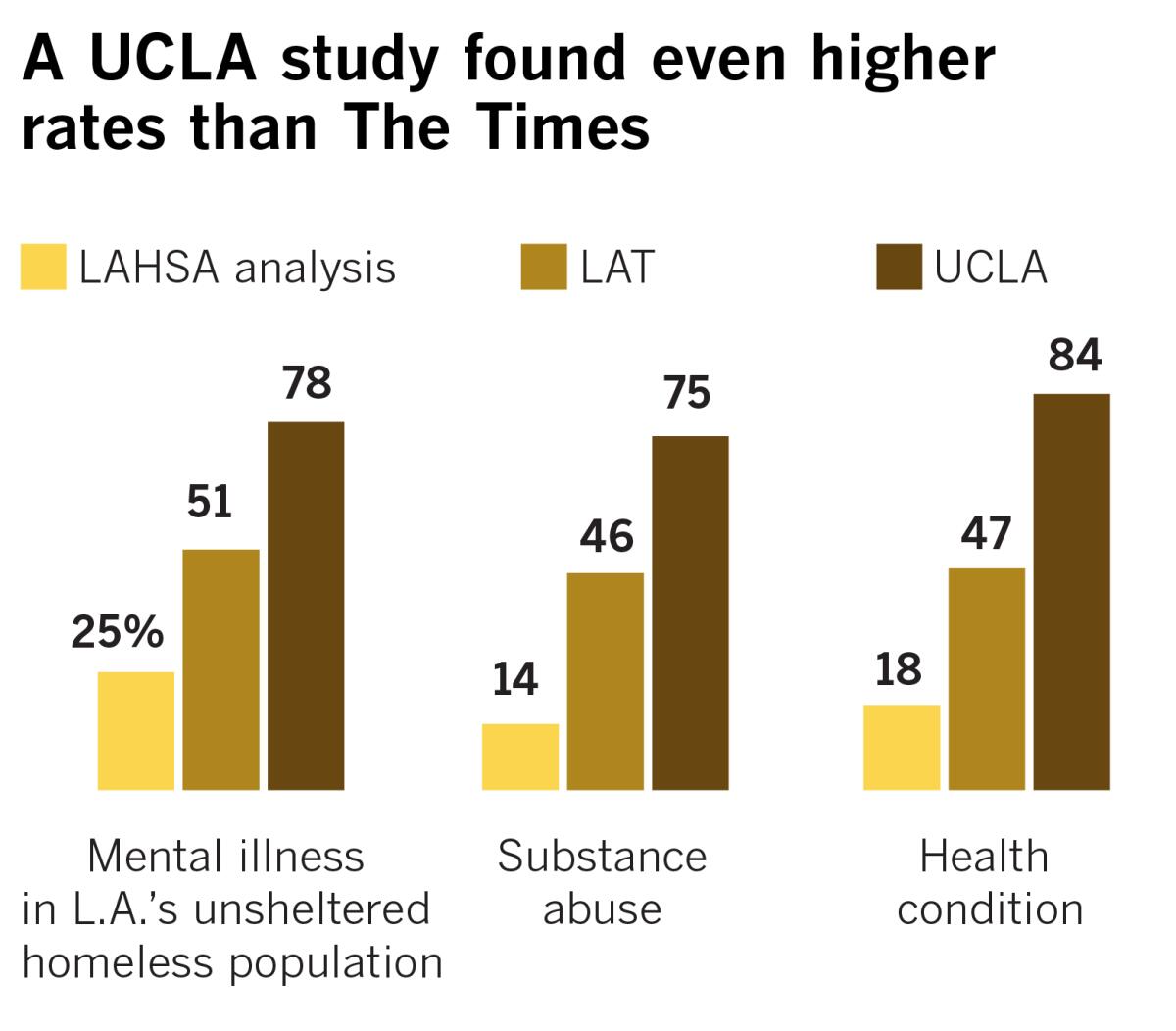
The findings lend statistical support to the public’s frequent association of mental illness, physical disabilities and substance abuse with homelessness. But neither the UCLA study nor the Times analysis suggests that these disabilities and health conditions alone cause people to end up on the streets. Elected officials and researchers largely agree that California’s affordable housing crisis and poverty are the primary drivers of homelessness.
Rather, both the analysis and the study illuminate a population struggling with complex mental health conditions and physical disabilities that interact and grow worse as people remain outside. Both data sets found mental and physical impairments to be far more prevalent among those living on the streets than in shelters.
The Times found that 50% of unsheltered people had two disabilities at the same time and 26% had three all at once — a condition known as tri-morbidity. UCLA researchers found tri-morbidity in half the population they studied.
The UCLA study also found that, among those who had been homeless for more than three years, 92% had a physical health condition — anything from cancer to an abscess.
In Los Angeles County, 75% of homeless people are unsheltered and, in 2018, the statewide rate of unsheltered homelessness was about the same.
Californians living in poverty and on the edge of homelessness have been crushed by soaring rents and sky-high home prices in recent years. A 2017 study by real estate firm Zillow found that a 5% rent jump in L.A. County would leave 2,000 more residents homeless.
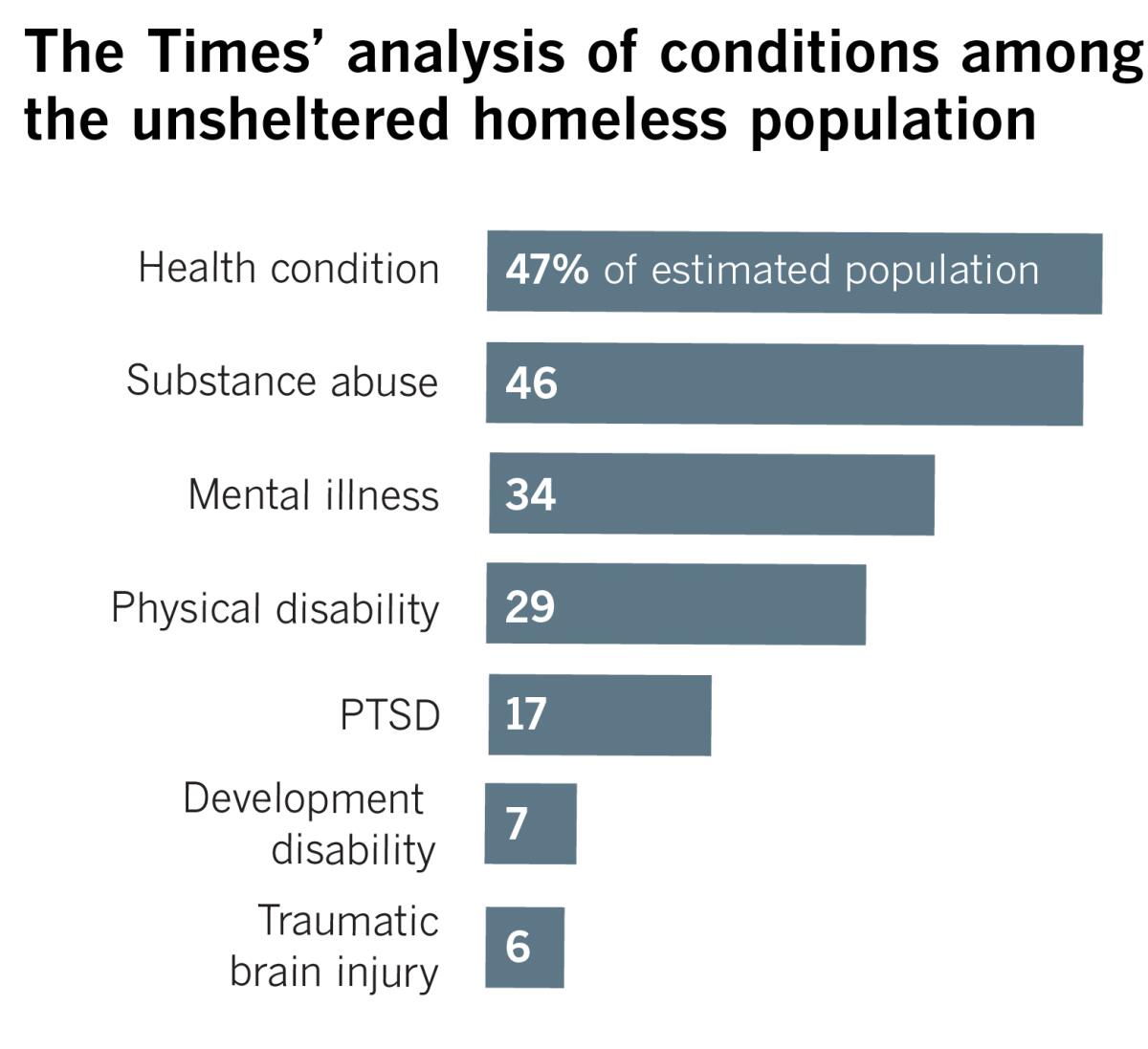
The research at UCLA, conducted by Janey Rountree, Nathan Hess and Austin Lyke, sought to offer empirical insight into a poorly understood community, Rountree said. The findings show a need for more attention to the physical and emotional distress of those on the street who are waiting for scarce housing opportunities.
She added that housing is crucial, but it won’t alone solve “these very deep medical, mental health and substance abuse issues.”
“There really needs to be an examination of the inflow of the unsheltered population, and are there issues of access to medical care, mental health care and to substance abuse treatment that are just as important as thinking about how to house them immediately when they do become homeless,” Rountree said.
Los Angeles County’s homeless initiatives — along with most initiatives across the state and the nation — emphasize what’s known as a “housing first” strategy. The primary focus is on getting chronically homeless individuals off the streets and into permanent housing, where they can access services to address mental and physical problems.
But the number of chronically homeless people in L.A. County — at nearly 17,000 as of January and growing — far exceeds the housing and shelters currently available. Even the thousands of new units being built with help from the $1.2-billion Proposition HHH homeless housing bond won’t be enough to close the gap.
“If being on the streets is bad for your health, then ‘housing first’ would be fine if everyone was going to be housed overnight,” said UCLA associate professor Randall Kuhn, who wasn’t involved in the research but said he plans to release a complementary study. “In the meantime, thousands will go unsheltered for years and thousands will enter homelessness directly to the streets. What are we supposed to do to help those people?”
At a time when cities and counties are struggling to respond to a growing number of street encampments, the UCLA study and Times analysis raise questions about whether government officials are taking the right approach and doing enough for people on the street who have little hope of getting into housing anytime soon.
The leaders of Gov. Gavin Newsom’s new homelessness task force have proposed enacting a legal right to shelter in California, which would force cities and counties to build enough shelter beds to accommodate any homeless person who seeks one. The state plan faces potential opposition, both from homeless advocates and from local officials, and lacks specifics on how the shelters would address the population’s acute needs.
University of Pennsylvania professor Dennis Culhane, a longtime researcher on homelessness, said that a weak social safety net that once supported Americans with disabilities has been worsening for decades, which has left more people on the streets.
“Most people with mental illness have a toehold in the housing market that they hang on to for dear life. But when it’s shaken by this man-made market disaster, they’re the ones who lose out,” Culhane said. “It’s easier to focus on mental illness, and you think you’re focusing on the problem when really it’s something you can’t see.”
Advocates for homeless people tend to not focus their messaging on mental illness, disabilities or substance abuse out of concern that doing so unfairly stereotypes and stigmatizes those without a home.
Briefing The Times on this year’s homeless point-in-time count prior to its release, Peter Lynn, executive director of the homeless authority, defended the agency’s statistics on homeless people with disabilities and substance abuse issues. He attributed the idea that the numbers should be higher to perception bias.
Like other local and state officials, he has portrayed the homeless population as being much like the wider population of housed Angelenos.
“What people remember are the cases that stood out, which are the cases of behavioral anomalies which is why, I think, people have a sense that there are more people that have serious mental illness,” Lynn said. “Most people with mental illness are housed. The vast majority of people with serious substance abuse issues are housed. They’re using their substances in their bedrooms and in their living rooms and you’re not watching it.”
Speaking on behalf of Lynn, who is on medical leave, Marston said the agency reports demographic statistics in the same format as other cities around the country. They all follow guidelines set by the U.S. Department of Housing and Urban Development.
But she conceded that the reports leave out data that would give a more complete picture of what’s happening on L.A. County’s streets, including the role that trauma plays in mental illness and substance abuse.
“It’s much deeper, and we have an opportunity to dig into that,” she said.
In a recent email to members of the agency’s board, Chairman Sarah Dusseault proposed that the agency work with the California Policy Lab to better understand the “urgent need of mental health or health services and to what extent do we need to drastically increase access to those services for those individuals in order to be able to house people.” The data, she added, would help the homeless services authority “consider how to fund and implement shelter to home initiatives.”
The Times found that the agency’s analysis of its demographic survey reached the lower numbers by excluding several responses related to health and mental health issues, as well as substance abuse.
For example, respondents’ disclosures of having serious mental illness, depression or PTSD were counted only if they also answered a secondary question stating that it was “permanent or long term.” That omission reduced the mental illness rate by 11.4 percentage points.
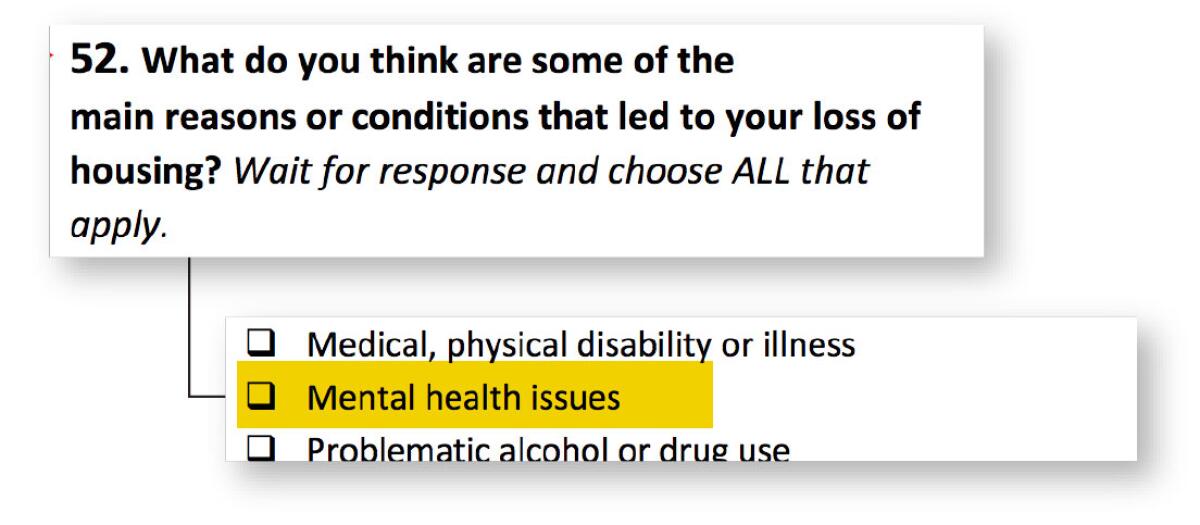
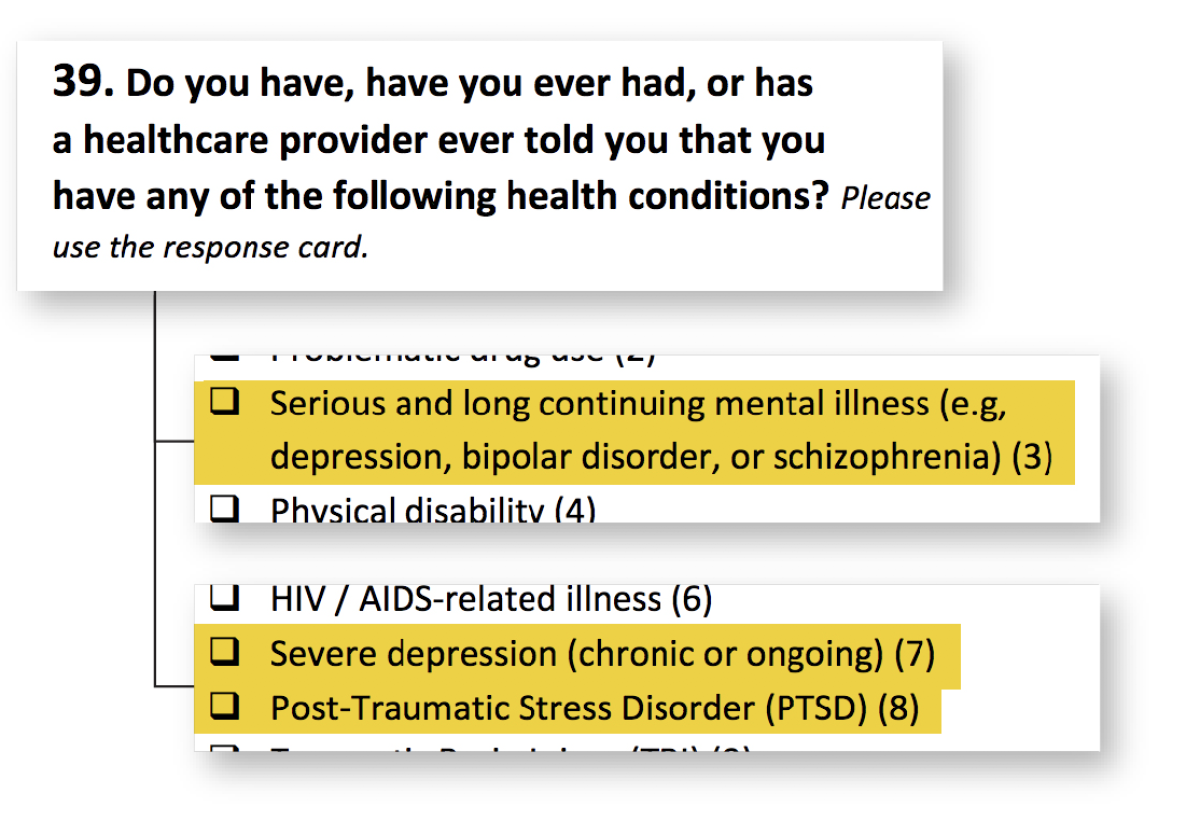

Patricia St. Clair, a senior member of the USC data team that analyzed the findings for the homeless authority, said the question was used to make the answers consistent with the federal definition of chronic homelessness. That definition requires a debilitating condition of a long duration, combined with a lengthy residence on the street.
She also said that omitting responses to the question was meant to screen out those who, for example, “had a bout of depression in adolescent years.”
Also, interviewers were asked to indicate if they observed a mental illness or substance abuse that was not disclosed by the respondent. Those observations were not included in the public report. If counted, they would have increased the rate of mental illness by 4.5 percentage points and substance abuse by 9 percentage points.
St. Clair said responses to that question were not appropriate to use because the interviewers were not qualified to assess the symptoms of mental illness or substance abuse. Their observations were only for the purposes of weighting the responses, she said.
Questions about whether a person’s disability contributed to becoming homeless also were not counted, and would have added 3 percentage points to the mental illness and 4.5 to substance abuse categories.
Differences between the findings by The Times and those of UCLA could reflect potential biases in the data sources, Rountree said.
The UCLA study analyzed a national sample of almost 65,000 questionnaires used to prioritize homeless people for housing. Because disabling conditions are required to qualify, outreach workers have an incentive to find them.
The Los Angeles Homeless Services Authority’s data, on the other hand, were collected as part of the local point-in-time count and were self-reported. As a result, respondents receive no benefit for providing sensitive information.
More to Read
Sign up for Essential California
The most important California stories and recommendations in your inbox every morning.
You may occasionally receive promotional content from the Los Angeles Times.

